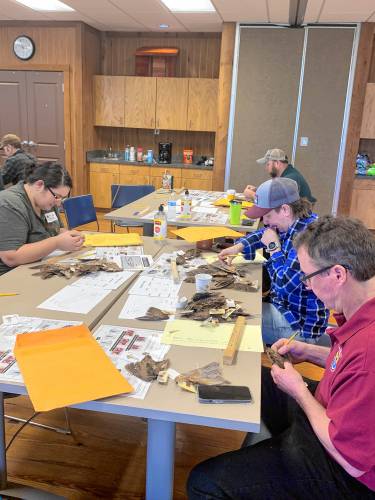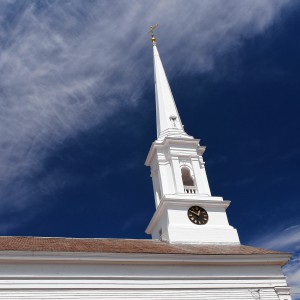Sportsman’s Corner: “A bunch of wing nuts”
|
Published: 03-21-2024 5:07 PM
Modified: 03-26-2024 4:34 PM |
By Mike Roche
“Must be a bunch of wing nuts!” was my wife’s comment about the people that this writer was flying to Alabama last week to join at the 2024 American Woodcock Wingbee.
She thought that my flying down there was a little wacky, but she does not share my passion for the American woodcock. The wingbee, however, is something which has been on my list of things to see for a number of years. It all started in 2006 when a letter appeared in my mailbox from the Unted States Department of the Interior. The official stationery on the letter included the logo of the United States Department of the Interior and the message which inquired as to whether I would be willing to assist in American woodcock research by contributing wings to the U. S. Fish and Wildlife Service’s Migratory Bird Wing Collection Survey.
As a lifelong bird hunter with a strong interest in wildlife conservation, it did not take me long to decide to respond and volunteer. Late that summer, a large envelope arrived that contained a supply of mailers and that began my time as one of the collectors for the survey, which began collecting woodcock wings in 1963. The clear instructions explained that one wing from each woodcock, rail, or bandtailed pigeon that I personally bagged on a single day’s hunt should be placed in the smaller inner envelope provided. That envelope would then be placed in the larger pre-addressed postage paid mailing envelope. On the outer envelope was a place for information, including the number of wings and species and the state, county and date of the hunt. Instructions to keep the mail clean were also provided, including how to remove the wings to make sure the feathers needed to determine age and sex were attached and measures that could be taken to ensure that the wings would not spoil. And so began my life as a wing collector!
I asked my good friend Dr. Steve Williams, former director of the U.S. Fish and Wildlife Service, if there was a way for me to get a chance to observe the activity with the purpose of writing a magazine article on the topic. He reached out to Rebecca Rau, who coordinates the bee, and arranged for me to attend. Then, a query was emailed to the editor of “Covers,” the magazine published by the Ruffed Gouse and American Woodcock Society, pitching my idea. When the article was approved, the trip was on!
My immersion into the 2024 American Woodcock Wingbee began with my arrival at the 5 Rivers–Alabama Delta Resource Center in Spanish Fort, Alabama, for day one. There were 23 people participating and a majority were from state and federal agencies, private organizations like the Ruffed Grouse and Woodcock Society, and university faculty. Staff in the U. S. Fish and Wildlife Service Migratory Bird Program’s Division of Migratory Bird Management, Branch of Assessment and Decision Support take the lead role in the analysis of the data that comes from the wingbee. Everyone made their way to a table and the quest for answers to my questions as a collector of woodcock wings was about to come to an end.
Each year the Woodcock Bee is held at a different location in the eastern half of the U.S. within the American woodcock’s range. That location rotates between northern, central and southern venues to provide state and federal biologists an opportunity to have it close by and host periodically. Rebecca Rau, a wildlife biologist and data administrator for the USFWS who serves as national coordinator for the Woodcock Singing Ground Survey and is the event coordinator for the wingbee. She presented a PowerPoint presentation that included a detailed progression of the current information on the woodcock population. Included were details on all the various tools used to gather information, including the Singing Ground Survey, the Harvest Information Program (a collaborative effort between the USFWS and the states which collects information on hunter activity and harvest data from all migratory bird hunters), and the Parts Collection Survey (wingbee). That was followed by a description of the wing identification process, and instruction on how to identify gender and sex using wings. Slides showed the “tools of the trade” which included special modified rulers to measure wings, clear metric measures for feather size, charts of the wing feathers showing what markings are used to determine age and sex, microscopes to be used in cases where the naked eye cannot discern feather details, and openers to get inside the 9,000 plus envelopes that filled 34 large boxes which had been kept refrigerated at the Laurel, Maryland, facility where they were sent by hunters.
Following a lunch break at great local restaurant (first time eating fried green tomatoes and crawdads. Yum!), it was time to get down to serious work. You need to successfully 24 of 25 wings age and gender to quality and about 10 % made it first try and most after three attempts. The work was really a team effort as experienced checkers would assist and help with wings where the keys, size of first three primary feathers (they produce the whistling sound woodcock are known for) and overall wing length for gender and the number 15 through 13 secondary wing feathers for age are not always clear when wings are degraded by hard-mouthed dogs (not mine!) or replacement of lost feathers. In three days, the task was to sex and age all those wings that arrived from the USFWS facility in Maryland. That breaks down to 428 wings per hour and over 400 per person!
Article continues after...
Yesterday's Most Read Articles
As a passionate woodcock hunter this immersion into data management, particularly when my wings had been part of the process for so long, was really interesting, regardless of my wife’s feelings. Added to that was waking up in a room with a closeup view of Mobile Bay and the Gulf of Mexico and it was a great getaway that was way too short!
Back home, the weather is what everybody is talking about. Please understand that black bears are already out and about so take in your feeders, at least at night.
Mike Roche is a retired teacher who has been involved in conservation and wildlife issues his entire life. He has written the Sportsman’s Corner since 1984 and has served as advisor to the MaharFish’N Game Club, counselor and director of the Massachusetts Conservation Camp, former Connecticut Valley District representative on the Massachusetts Fisheries and Wildlife Board, has been a Massachusetts Hunter Education Instructor and is a licensed New York hunting guide. He can be reached at mikeroche3@msn.com.






 Over $400M in shelter funding, new limits approved
Over $400M in shelter funding, new limits approved Royalston’s FinCom debates proposed salary increases
Royalston’s FinCom debates proposed salary increases PHOTO: Spectacular spire
PHOTO: Spectacular spire Locking up carbon for good: Easthampton inventor’s CO2 removal system turns biomass into biochar
Locking up carbon for good: Easthampton inventor’s CO2 removal system turns biomass into biochar